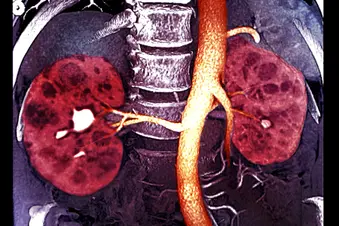
Autosomal dominant polycystic kidney disease (ADPKD) is a genetic disorder that causes fluid-filled cysts to grow in your kidneys.
ADPKD is progressive, which means it gets worse over time. In fact, it often results in chronic kidney disease, a gradual loss of kidney function.
As your ADPKD gets worse, you may get chronic kidney disease, which has five stages.
Doctors stage kidney disease according to a test called estimated glomerular filtration rate, or eGFR. This measures how well your kidneys filter waste and extra fluid from your blood.
Stage 1: eGFR of 90+
If you have an eGFR of 90 or higher, that means your kidneys are working at 90% or better. You may have some of these symptoms that can occur with anyone with ADPKD:
- Blood in your pee
- Urinary tract infections
- Kidney stones
- Brain aneurysms
Stage 2: eGFR of 60-89
Usually, kidneys are considered healthy and working fine in stage 2. Still, you may notice health changes that are known to be early signs of the disease – some of which can also happen in stage 1. These include:
- High blood pressure
- A heavy or full feeling in your abdomen (belly)
- Back pain
- Belly pain
Stage 3: eGFR of 30-59
By stage 3, your kidneys aren’t working well. You might not have any symptoms, or you may notice more signs of damage, like:
- Swelling in your hands and feet
- Back pain
- Peeing more or less than normal
You may feel more pain and notice your belly is fuller as your kidney cysts get bigger and your eGFR gets lower. Pain can also lead to depression, which is common in people who have ADPKD. Let your doctor know if you notice changes in your mood so you can take care of your mental health, too.
Stage 4: eGFR of 15-29
This is considered advanced kidney disease. You’ll likely have problems with swelling, pain, and peeing a lot that started for some people in stage 3. You may also have other health problems due to waste buildup in your blood. These can include anemia (low red blood cell count) and bone disease.
This is a good time to talk to your doctor about how to prepare for kidney failure. Dialysis is a common next step. It helps clean your blood when your kidneys can’t. You should also ask if a kidney transplant is right for you and how to proceed with one.
Stage 5: eGFR of less than 15
This means your kidneys are close to failing or have failed. It doesn’t happen often in people under 40 with ADPKD. But by the time you’re between 70 and 75, the likelihood of kidney failure from ADPKD is 50%-75%. The age of kidney failure also depends on your genetics and family history. Stage 5 symptoms include:
- Weakness or drowsiness
- Headaches
- Confusion
- Nausea, vomiting, or decreased appetite
- Itching
- Muscle cramps
- Shortness of breath
- Gray or yellow skin color
- Metallic taste
Some things that make kidney failure more likely with ADPKD include:
- Enlarged kidneys
- Being male
- Having a PKD1 mutation (one of two genetic mutations that cause ADPKD)
- High blood pressure, especially if it developed before age 35
The doctor will monitor your ADPKD, but it’s always smart to be an active partner in your health. Keep them informed of all your symptoms and concerns, especially in the later stages of ADPKD. That helps you both have plenty of time to plan for dialysis or begin the process of getting a kidney transplant.